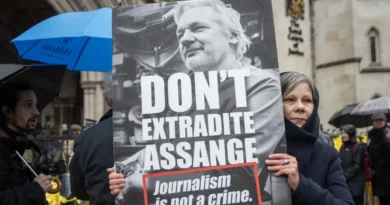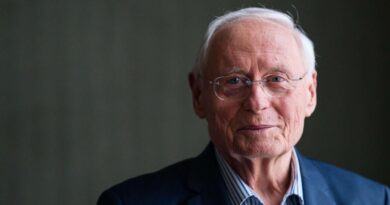Achieving the two-state solution in the context of the Gaza war
Peace can come through the immediate implementation of the two-state solution, making Palestine's admission to the United Nations the starting point, not the end point.
JEFFREY D. SACHS AND SYBIL FARES
The two-state solution is enshrined in international law and is the only viable path to lasting peace. All other solutions - continuation of Israel's apartheid regime, a binational state or a unitary state - would guarantee the continuation of the war by one or both sides. However, the two-state solution seems hopelessly blocked. But it's not like that. Here is a way.
The Israeli government is firmly opposed to a two-state solution, as is a significant portion of the Israeli population, some for religious reasons (“God gave us the land”) and others for security reasons (“We can never be safe with a State of Palestine. A significant proportion of Palestinians consider Israel to be an illegitimate settler-colonial entity and, in any case, distrust any peace process.
How to proceed then?
The usual recommendation is the following six-step sequence (1) ceasefire; (2) release of hostages; (3) humanitarian aid; (4) reconstruction; (5) peace conference for negotiations between Israel and Palestine; and finally (6) establishment of two states on agreed borders. This path is impossible. There is a perpetual deadlock in steps 5 and 6, and this sequence has failed for 57 years since the 1967 war.
Two sovereign states, on the borders of June 4, 1967, initially protected by UN-backed peacekeeping forces and other guarantees, will be the starting point of a global and just peace…
The Oslo failure is the paradigmatic case. There are irreconcilable differences, such as the status of East Jerusalem. Israeli fanatics would expel from power any Israeli politician who dared to cede East Jerusalem to Palestinian sovereignty, and Palestinian fanatics would do the same to any Palestinian leader who renounced sovereignty over East Jerusalem. We should give up the continued illusion that Israel will ever reach an agreement, or that Palestine will ever have the bargaining power to engage in meaningful dialogue with Israel, especially when the Palestinian Authority is heavily dependent on the United States and other financiers.
Therefore, the correct approach is the opposite, starting with the establishment of two states on globally agreed borders, in particular the June 4, 1967 borders enshrined in UN Security Council and General Assembly resolutions. UN member states will have to impose the two-state solution, rather than wait for another Palestinian-Israeli negotiation to fail.
Thus, the solution should follow the following order: (1) establishment of Palestine as the 194th Member State within the framework of the two-state solution on the borders of June 4, 1967; (2) immediate ceasefire; (3) release of hostages; (4) humanitarian aid; (5) peacekeeping, disarmament and mutual security forces; and (6) negotiation on modalities (settlements, return of refugees, mutually agreed land exchange and others; but not borders).
In 2011, the State of Palestine (now recognized by 140 UN member states, but not yet as a UN Member State) applied for full member status of the UN. The Committee of New Members of the UN Security Council (constituted by the UN Security Council) recognized the legitimacy of Palestine's request, but as is absolutely typical in the "peace process", the US government prevailed. on the Palestinian Authority to accept “observer status,” with the promise that full UN member status would soon follow. Of course, it wasn't like that.
The Security Council, backed by the UN General Assembly, has the power, under the UN Charter, to enforce the two-state agreement. It can do so as a matter of international law, after decades of relevant resolutions. It can then impose the solution through a combination of carrots (economic incentives, reconstruction funding, UNSC-backed peacekeeping forces, disarmament, border security, etc.) and sticks (sanctions in case of violation by anyone of the parts).
The only conceivable border to create the two-state solution is that of June 4, 1967. Starting from that border, the two sides could mutually negotiate a mutually beneficial land exchange, but they would do so knowing that the “best alternative to a negotiated agreement” (BATNA) is the border of June 4, 1967.
It is very possible, in fact probable, that the US will initially veto the proposed route. After all, the United States has already used its veto on multiple occasions to block a simple ceasefire. However, the process of obtaining the US veto and then achieving a large majority vote in the UN General Assembly will be beneficial for three reasons.
First, American policy is rapidly shifting against Israeli policies, given the American public's growing understanding of Israel's war crimes and Israeli political extremism. This shift in public opinion makes it much more likely that American leaders will accept, sooner rather than later, the basic approach outlined here given the domestic political dynamics of the United States. Second, the increasing isolation of the United States in the UN Security Council and General Assembly is also weighing heavily on US leaders and forcing them to reconsider their policy positions in the light of geopolitical considerations. Third, a strong vote in the UNSC and UNGA in favor of the two-state solution on the June 4, 1967 borders will help strengthen international law and the terms of the eventual agreement as soon as the veto is lifted. US.
For these reasons, there is a realistic prospect that the UN will eventually exercise its international legal and political authority to create the conditions necessary for peace.
Twenty-two years ago, Arab and Islamic leaders affirmed in the 22 Arab Peace Initiative that the only path to peace lies through a two-state solution. On February 2002, 7, the Saudi Foreign Ministry reaffirmed that complete peace will only be achieved by recognizing an independent Palestinian state on the 2024 borders and East Jerusalem as its capital. Arab states and the broader world community should not swallow another vague peace process that is likely doomed to failure, especially given the urgency caused by the ongoing genocide in Gaza and the ill will built up over the past 1967 years of a “Process of Peace” unsuccessful.
Peace can come through the immediate implementation of the two-state solution, making Palestine's admission to the UN the starting point, not the end point. Two sovereign states, on the borders of June 4, 1967, initially protected by UN-backed peacekeeping forces and other guarantees, will be the starting point for a comprehensive and just peace not only between Israel and Palestine, but also for a regional peace that ensures diplomatic relations throughout the Middle East and puts an end to this conflict that has overwhelmed its inhabitants, the region and the world, for more than a century.










